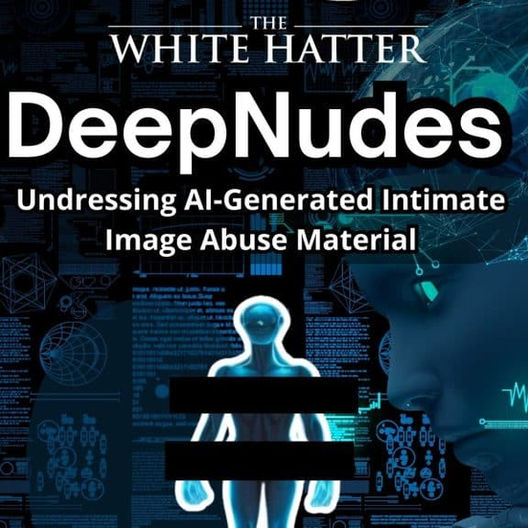Seeing is No Longer Believing”, The Erosion of Visual Truth in the Age of AI
- The White Hatter

- Jun 17
- 8 min read

For generations, we've trusted our eyes. "Seeing is believing," we said. If something appeared in front of us such as a photo, a video, a text , we took it at “face value” and credible. However, artificial intelligence (AI) has flipped that script. What we now see with our own two eyes may not only be misleading , it may be entirely fabricated.
In the hands of youth, this technology presents both incredible creative opportunities and dangerous new forms of harm. As parents, caregivers, and educators, understanding the implications of AI-generated content is essential for guiding young people through a world where digital fakes can appear indistinguishable from the truth.
We here at the White Hatter have now seen “some” youth and teens use artificial intelligence to create hyper-realistic:
Fake screenshots of text messages or social media posts
Videos of people doing or saying things they never actually did
Non-consensual intimate images or explicit content from innocent photos, and
Deepfake audio that mimics a person’s voice with alarming accuracy
These tools are not hypothetical or reserved for tech-savvy adults. They're often accessible via simple apps or websites marketed directly to youth. In some cases, they're being used not only to embarrass or manipulate others, but to harm oneself, intentionally.
When young people use AI to create fake content, it can start off as a joke or an attempt at humour, but it can quickly cross into the area of cyberbullying, harassment, or even criminal activity. Consider these examples:
A student fabricates a screenshot of a teacher texting something inappropriate.
A teen doctor’s a video of two classmates kissing, then shares it to damage reputations.
A fabricated nude image of a peer is spread online, leading to emotional trauma or disciplinary fallout.
Such content may look real, and that’s the problem. By the way, these aren’t hypothetical scenarios, these are three examples of incidents we helped schools and parents with here at the White Hatter.
One of the most concerning, and often overlooked, phenomena is the intentional self-targeting by youth and teens using digital means.
Dr. Sameer Hinduja and Dr. Justin Patchin from the U.S.-based Cyberbullying Research Center found that approximately 12% of teens have “self-cyberbullied”, posting cruel things about themselves or creating false evidence of being attacked, often to gain sympathy, attention, or support.
AI and editing tools have now made this easier and more convincing than ever to make things look extremely real. A student could, for instance, create fake hateful messages from classmates or generate images that falsely suggest victimization. While the underlying emotional needs are real, the “evidence” being shared isn’t, and this matters deeply in how schools and families respond.
What does this means for educators and school administrators?
Educators are often the first responders to peer conflict or digital harm. In today’s AI-augmented reality, it is critical that schools not assume digital content is authentic without verification, and the reality is that this may be extremely hard to do. Here are some steps that we suggest for consideration:
1. Verify First
Always request access to the original version of any digital content brought forward as evidence. This includes images, videos, or messages. Screenshots can easily be fabricated or altered using free editing apps or AI tools.Ask for:
Access to the original device the content was created on
Metadata (information embedded in files such as time, date, and location)
Timestamps from platforms or apps
Contextual information (such as preceding or following messages)
Digital evidence is now easily manipulated. A screenshot, once considered reliable, may no longer be sufficient proof. Without original sources, the potential for misinterpretation or manipulation is high, and acting on false evidence can severely damage a student’s reputation or well-being and place the school in legal jeopardy.
2. Involve IT or Law Enforcement When Needed
If digital evidence seems suspicious, ambiguous, or unusually high-stakes (such as involving threats, intimate imagery, or reputational damage), involve:
Your school’s IT or digital security team (if available)
The local police department’s digital forensics unit if they have one
Educators are not digital forensics experts. Trying to determine whether content is real or fake without the proper tools or training can lead to errors. Law enforcement and IT professionals have the software, skills, and experience to analyze file metadata, detect deepfakes, and uncover the truth behind suspicious content. It protects both the alleged victim and the accused from injustice.
3. Avoid Public Conclusions
Never confront students publicly or discipline them based solely on digital content, especially before it has been thoroughly verified. Handle all accusations and digital evidence privately, respectfully, and with discretion.
False accusations, especially when fuelled by AI-generated or altered media, can cause irreversible harm. Public confrontations or rushed disciplinary actions can lead to reputational damage, bullying, or emotional distress. Due process matters, especially in a digital age where visual “evidence” can’t be taken at face value.
4. Train Staff
Provide ongoing professional development that includes:
Understanding deepfake technology and AI-generated content
Recognizing signs of altered digital files or screenshots
Knowing how to handle cases of non-consensual image sharing
Learning appropriate digital reporting protocols
Collaborating with digital literacy experts or guest speakers
Most educators did not receive training in spotting AI-driven digital deception as part of their formal education. Yet today’s students are immersed in this reality. Without proper training, staff may underestimate the sophistication of fake content, or overreact to content that appears authentic but is digitally fabricated. Staying informed empowers educators to respond wisely and fairly.
5. Support All Students
Whether a student is being targeted or is intentionally targeting themselves (as seen in cases of self-cyberbullying), prioritize emotional and psychological support. Involve:
School counsellors
Trusted adults or mentorship programs
External mental health services if necessary
Also, create safe spaces for students to come forward about fake content without fear of automatic punishment.
Some students may be using fake content to seek help in unhealthy ways. Remember, research from the Cyberbullying Research Center shows, around 12% of teens self-cyberbully to gain attention or express distress. Behind every image or accusation is a story, and often, a struggle. A punitive-first approach can silence students who need support, while a trauma-informed, empathetic response can build trust and resilience.
So what does this means for parents and caregivers?
Parents and caregivers must stay engaged and informed. This is not about becoming paranoid, it’s about becoming digitally literate alongside your child. Here’s how:
1. Talk About Truth
Start age-appropriate conversations about how digital content can be altered or completely fabricated, whether it’s a viral video, a screenshot of a message, or an AI-generated image. Reinforce that while technology is amazing, it also requires critical thinking.
Suggested talking point to start the conversation:
"Have you ever seen something online that looked real but wasn’t? How did you figure it out?"
Young people are growing up in a world where “seeing is believing” no longer applies. Teaching them to question digital content, especially when it sparks big emotions like anger, fear, or shame, helps them avoid being manipulated or caught in drama.
Also emphasize that creating fake content, even “as a joke”, can have serious reputational, emotional, and legal consequences.
2. Check In Without Snooping
Create a home environment where your child feels safe talking about what they see and experience online, without fearing immediate judgment or punishment. This includes checking in regularly about what’s happening in their digital world.
Instead of surveillance, try curious conversation starters such as:
“Have you seen any AI-generated videos or memes lately?”
“Do you know anyone who’s had a fake account made about them?”
When youth and teens know you’re not out to catch them doing something wrong, but instead genuinely want to understand, they’re more likely to share, including about concerning things like impersonation, fake images, or AI-driven drama. Teens often have insight into trends long before adults do, but many don’t speak up because they assume parents won’t understand or might overreact.
3. Don’t Overreact
If your child becomes the target of a fake video, message, or image, or is accused of sharing one, your first job is to stay calm. Ask open-ended questions like:
“Do you think this could be fake or altered?”
“Do you know where it came from or how it started?”
“Have you saved the original file or message?”
Then, help gather the facts. In serious situations (e.g., threats, non-consensual images), contact the school or local police, but do so with a clear head and evidence in hand.
A panicked or punitive reaction can shut your child down or push them away. In today’s onlife world, teens may face accusations or fallout from AI-generated content that they didn’t even create or share. Your job is to be their advocate, not their interrogator.
4. Be Curious, Not Fearful
Learn about AI and deepfakes with your child. Watch a video together explaining how AI can generate fake voices, faces, or messages. Explore a fun tool like an AI image generator or chatbot, and then talk about the ethics of creating things that look real but aren’t.
Ask your child:
“What do you think is cool about this?”
“What do you think could go wrong?”
“How would you tell what’s real or fake?”
AI is part of your child’s world, in the tools they use at school, the videos they watch, and the content their peers share. Instead of trying to shield them from it, help them build the digital skills to question, analyze, and navigate it. Being informed together builds trust and opens communication, making you a safe, relevant guide rather than a reactive gatekeeper.
In today’s onlife world where artificial intelligence can fabricate digital realities with unsettling ease, the old adage "seeing is believing" no longer holds true. For today’s youth, and the adults guiding them, separating truth from fiction is no longer optional, it's essential. The erosion of visual truth doesn't just threaten reputations or emotional well-being, it challenges the very foundation of how we perceive reality and make decisions.
With this challenge, however, comes an opportunity to educate, to engage, and to evolve. The answer is not to retreat in fear or overreact with blanket suspicion, but to respond with digital literacy, curiosity, and empathy. Whether you’re a parent, an educator, or a student, your role in this moment is not about perfect knowledge or control, it’s about being present, asking questions, and thinking critically about the digital content that floods our lives.
We must stop assuming that everything presented to us on a screen is inherently trustworthy. We must teach our children to verify before they amplify, to question before they judge, and to understand that what’s fake can still cause very real harm. Just as we’ve learned to detect scams and spam, we must now learn to detect manipulation by machine.
At The White Hatter, we’ve seen both the risks and the potential of this AI revolution. While we cannot stop the evolution of technology, we can prepare our youth to live wisely within it because in the end, the most powerful defence against digital deception isn’t stronger filters or tighter controls, it’s smarter, more resilient humans.
Today’s generation is growing up in a world where truth is more easily editable than it was in the past. That’s not an overstatement, it’s our new reality.
Truth is no longer just what we see. It’s what we verify, understand, and stand up for together.
That’s why we continue to emphasize that in today’s AI-driven onlife world, digital literacy isn’t just a skill, it’s the new common sense. It’s essential not only for recognizing and preventing the misuse of AI, but also for harnessing its power in thoughtful, responsible, and positive ways.
Digital Food For Thought
The White Hatter
Facts Not Fear, Facts Not Emotions, Enlighten Not Frighten, Know Tech Not No Tech














